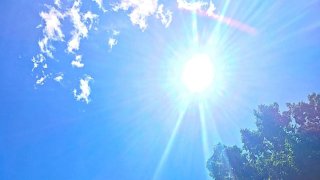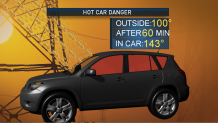
It is that time of year -- the extended forecast shows sunshine and heat with what seems like no end in sight.
The sun and heat can be dangerous and, at times, deadly. Heat is the number one cause of weather-related deaths. According to a National Weather Service report, in a 10-year period, more people lost their lives from heat than any other type of weather disaster.

Heat deaths are preventable.
Make sure if you are outside or work outside that you take frequent breaks in the shade or air conditioning. Check on people who do not have air conditioning. Drink plenty of water to keep hydrated. Drink water even if you don’t feel thirsty. Dress in light-colored, loose fitted clothes.
Know the symptoms of heat exhaustion: Heavy sweating; cool, clammy skin; fast weak pulse; nausea or vomiting; muscle cramps; tiredness; dizziness; fainting, or headache.
What to do: Move to a cool place; loosen your clothes; put cool, damp cloths on the body; and sip water. Get medical help if you are throwing up or if your symptoms last longer than one hour.
Local
The latest news from around North Texas.
Know the symptoms of heatstroke: Body temperature over 103 degrees, redness to your skin, fast and strong pulse, dizziness, headache, nausea, confusion, losing conscience (passing out). If these symptoms are present call 911 right away. Try to lower the person's body temperature with a cool damp towel or a cool bath. Do not give the person anything to drink.
Never leave children or pets in a car! Even with the windows cracked, the inside of a car can become deadly in just a matter of minutes. On a 90 degree day, it only takes 10 minutes for the internal temperature of your car to reach 109 degrees. Within 30 minutes, the internal temperature can exceed 125 degrees. On a 100 degree day, the internal temperature can reach 143 degrees in an hour.

The sun can also be dangerous. According to the Skin Cancer Foundation, one in five people will develop some type of skin cancer by the age of 70. Having five or more sunburns doubles your risk for getting melanoma.
The UV Index is included in our daily forecasts. A value of 8 or higher means very high exposure. A person not protected could experience a burn in as little as 15- 25 minutes. Avoid being in the sun between 10 a.m. and 4 p.m. when the UV rays are most intense. The CDC recommends if you are outside, make sure you are wearing a sunscreen with an SPF of 15 or higher and reapply every two hours.

Being in the sun unprotected can also prematurely age you. Allison Tohlen, Lead Medical Aesthetician at Eleven Wellness in Dallas, recommends a wide-brimmed hat (a baseball hat does not have enough coverage for the sides of your face) and applying an antioxidant before your sunscreen. Tohlen also recommends after a day in the sun to cleanse with cool water and apply a face mask with a hyaluronic base. The sun can also dry out your skin.
Keep a close eye on kids at the pool and make sure they don’t have access to areas of water without an adult.

Children should get 100% of your attention. According to the U.S. Centers for Disease Control and Prevention, one in five people who die from drowning are children 14 years old or younger. Most drownings occur in home swimming pools. Drowning is one of the top causes of death among children one to four years old.



